Instructions for making a copper pennywhistle in the key of D
This item is presented here courtesy of Kim Fulton-Bennett. Additional information on pennywhistles, instructions on how to make music with these whistles, their care and feeding, and adjusting their tone/tuning are available on his Web site.
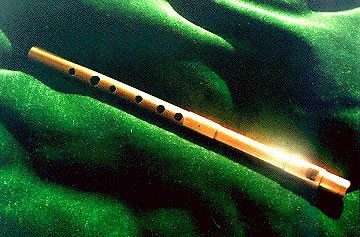
What You Will Need
You can make a fine whistle with just simple hand tools and materials that you can buy at any hardware store!
Tools
- A ruler marked in cm and mm, as well as inches.
- Electric hand drill or drill press.
- Drill bits in 1/32" (0.75 mm) increments.
- Sand paper (120- to 220-grit).
- Small flat or triangular file less than 1/4" (6-7 mm) wide.
- Large flat-sided metal file about 1 1/4" (3 cm) wide.
- Rat-tail (cylindrical) file about 1/4" (6-7 mm) diameter.
- Flat-bladed screwdriver with blade about 1/4" (6-7 mm) wide.
- Sharp metal punch for setting holes for drilling (a large pointed steel screw or bolt will also work).
- Steel bar with flat end about 1/4" (6-7 mm) square.
- Hack-saw with a metal-cutting blade.
- Chromatic electronic tuner or (for those with a good ear) electric keyboard. You can try to tune the whistle to another wind instrument, but I don't recommend it because you can't play both instruments at once to hear the beats when notes are out of tune.
- Optional but recommended: Table vice (handy for holding the pipe-be sure to add padding to the metal grips so you don't scratch the copper).
- Optional but recommended: Pipe cutter (an inexpensive hand tool that gives a nice, straight end to the pipe).
Materials
- 1/2" copper plumbing pipe (Type M in the U.S.). You only need 12-inches (30 cm) for a whistle, but you might want to buy two or three times this much, just in case.
- Copper connector (sleeve) used to join two lengths of 1/2" copper pipe (use the kind of connector that has a "stop" hammered into middle of the connector; my measurements take this into account).
- 5/8" Hardwood doweling: a 12-inch length is plenty. (Get 9/16" dowel instead, if you can find it).
- Two-part epoxy resin (having the consistency of honey, safe for putting in your mouth when dry).
- Optional: Can of spray lacquer.
Conventions and Notes
- In these instructions, "up" refers to the end of the whistle or fipple closest to your mouth (while you are playing). "Down" refers to the end closest to your feet. "Front" refers to the side of the whistle with the fipple and finger holes. "Back" refers to the side without holes.
- You might be able to use metric-sized copper pipe instead of standard U.S. 1/2" pipe, but all the other dimensions will probably change a bit.
- I sincerely apologize for my "unitary schizophrenia" (there's an oxymoron!). My tools are all sized in "English" units, but I prefer to use metric units for all my distance measurements because it is easier to scale them up or down to build whistles in different keys.
- Whenever I file, sand, or polish copper, I wear a dust mask. I have found that fine copper dust dust or powder irritates my throat and lungs. You probably don't want to swallow it either. However, I believe the amount of copper you ingest from playing a finished whistle is minimal (please let me know me if I'm wrong!).
Making the Fipple
NOTE: The fipple is the hardest part of the pennywhistle to make. I often make more fipples than I need, and end up throwing out some of them because I'm not happy with their sound...
Cutting the Pipe
- Measure and cut off a 3.5-cm length of pipe. This will be the fipple. Use the pipe cutter if you have one.
NOTE: the sharp ends of the cut pipe can slice your fingers, so caution is advised. - Cut a second piece of pipe 26 cm long. This will be the body of the whistle.
- Deburr the ends of the pipes (use pipe cutter tool). Then smooth both ends of pipe using first the wide flat file and then sand paper.

Attaching the Sleeve
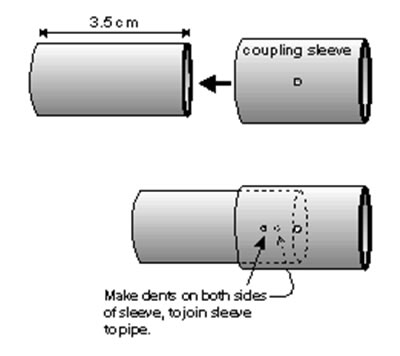
- Slide the sleeve onto the 3.5-cm length of pipe.
- Use the punch to make a dent in each side of the sleeve to secure it to the pipe.
Cutting the Fipple Hole
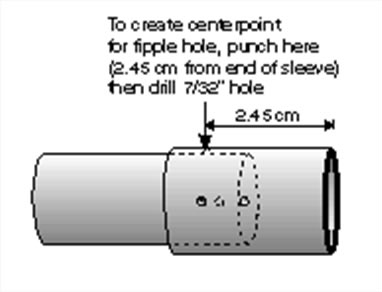
- Measure up 2.45 cm from the free end of the sleeve and scratch a line with the punch.
- Use the punch to create a dent on this line. This dent will be the center point for the fipple hole.
- Drill a 7/32" (6mm) hole at this spot.
- Use the small file to shape this round hole into a neat rectangle about 1/4" (0.65 cm) long and 5/16" (7.5 mm) wide. The lower lip of this hole should be 1.75 cm from the end of the sleeve (see picture below).
NOTE: It is important to make all the edges, inside and out, as smooth and neat as possible.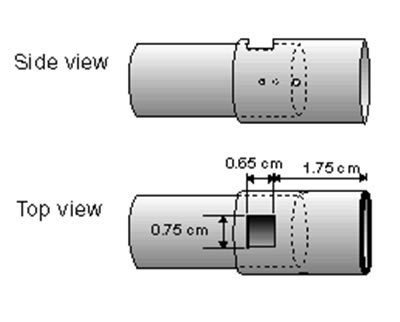 NOTE: For a lower whistle, such as a C, make the fipple hole slightly longer (7 mm); for a higher whistle, make the fipple hole slightly shorter (4-5 mm). In either case, the lower edge of the fipple hole should still be 1.75 cm from the end of the pipe.
NOTE: For a lower whistle, such as a C, make the fipple hole slightly longer (7 mm); for a higher whistle, make the fipple hole slightly shorter (4-5 mm). In either case, the lower edge of the fipple hole should still be 1.75 cm from the end of the pipe. - Place the flat-tipped metal bar on the lower edge of the fipple hole and tap on it with a hammer to bend the copper in about about 1-2 mm, as shown below.
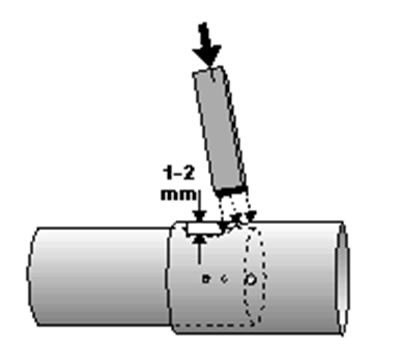
- If the bent-in edge is curved rather than flat, use the screwdriver to reach in from the top of the fipple and make the edge as flat as possible (see below):
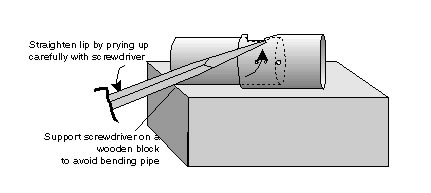
- Use the small file to create a smooth, beveled "cutting edge" about 2 mm wide on the outer, lower edge of the fipple hole (see picture below). This edge must be as smooth and straight as you can make it.
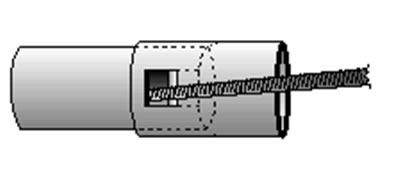
- Use sand paper to smooth the upper end of the tubing above the fipple hole, inside and out. This is where your lips will contact the metal, so you don't want sharp places...
Making the Fipple Plug
- Take the 5/8" hardwood dowel and reduce it's diameter to fit snugly inside the copper pipe. The final diameter should be about 9/16" (if you can get 9/16" doweling, please let me know).
NOTE: One way to reduce the diameter of the dowel is to use a "poor-man's lathe" ( Warning: This will ruin the bearings in your drill if you do it too much): -
- Screw a 1/8" wood screw about into the exact center of one end of the dowel until only about 15 mm is left exposed.
- Cut off the head of the screw with a hack saw.
- Insert the exposed body of the screw into the chuck of an electric hand drill.
- Hold the hand drill horizontally and run it while holding coarse sand paper next to the doweling. Make sawdust until the dowel is thin enough so that a piece of pipe (without burrs or lip) fits snugly over the dowel.
- Now cut off a 1 inch (2.5 cm) piece of your (newly lathed) 9/16" dowel and smooth the ends with the flat file.
- Decide which side of the plug should have the wind channel cut into it (I'm not sure which side is best: going "with the grain" gives you a smoother surface, but this side may be more prone to swelling).
- Use the large flat file to flatten the side of the dowel where you will cut the wind channel. The flattened area should be trapezoidal: about 9 mm wide at one end and about 7.5 mm wide at the other end of the dowel (see picture below).

- Use the small file to cut a channel into this flattened surface. This channel should be about 2 mm deep at the wide (upper) end and 1+ mm deep at the narrow (lower) end (see picture below). Make sure the surfaces and sides of this channel are as smooth and flat as possible.
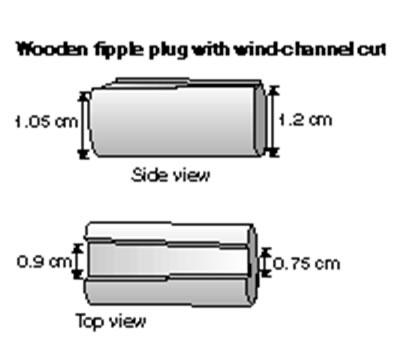
- (optional) Seal the wind channel and lower end of the fipple plug with epoxy or some other hard, waterproof sealant (I'm not sure if this makes much of a difference).
Mounting and Adjusting the Fipple
- Insert the plug into the end of the pipe above the fipple hole. The narrow, shallow end of the channel should be pointed toward the fipple hole. Sight through the channel to make sure that the lower end of the channel is parallel to the lower edge of the fipple hole. Slide the plug into the pipe until the lower end of the plug is even with (directly beneath) the upper edge of the fipple hole (see picture below).
NOTE: If the plug will not stay put, use a small piece of paper as a shim. Fold it if necessary and insert it along the back of the plug to keep it from sliding.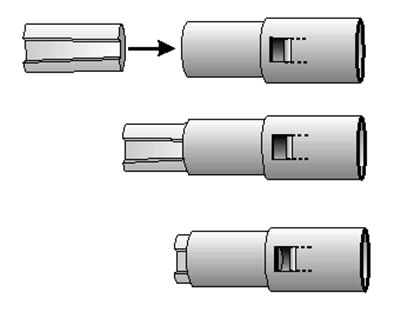
- At this point, you need to try out the fipple to see how it sounds when attached to the body of the whistle. Slide the fipple (with plug) onto one end of the 26-cm length of pipe you cut earlier.
- Wipe the dust off the fipple, then blow into the end. You should get a clean, if slightly weak note (roughly D one octave above middle C). The point here is not to check the tuning of the note, but to test the timbre of the fipple--whether it makes a clear tone or a breathy one.
- If you're happy with the tone produced, continue to step 5 below. If you want to try adjusting the sound, here are some suggestions (this is art, not science):
NOTE: Some of these adjustments are irreversible: if you adjust too far, you will have to start over, and create an entirely new fipple.- If the note is too breathy, some air is missing the lower edge of the fipple hole. Try one of the following:
- Slide the fipple plug about 0.5 mm toward the fipple hole. (If you go too far, just push the plug back out and try again.)
- Look down through the wind channel. The lower end of the channel should line up with with the bent-in edge of the fipple hole. If can see a wide gap between the two, you can try bending the lower edge of the fipple hole down slightly (this is tricky!). You can also try making a new plug with a shallower channel.
- If the note tends to "break" and go into the upper octave rather than the lower octave, try one of the following:
- Slide the fipple plug up about 0.5 mm (away from the fipple hole).
- Try deepening the entire channel in the fipple plug slightly (say: 0.5 mm).
- Try bending the lower edge of the fipple hole up with a screwdriver, then smooth the edge as necessary.
- If the note has good tone, but is not loud enough, try one of the following:
- Deepen and/or widen the upper end of the channel in the fipple plug. Make sure all surfaces are smooth and even.
- Widen the fipple hole slightly with a small file (work on both sides). Be careful not to make the hole too wide or the whistle will become breathy.
- If the note is too breathy, some air is missing the lower edge of the fipple hole. Try one of the following:
- When you are happy with the sound of the fipple and you are sure the fipple plug is in the correct location, secure the plug by denting the copper pipe around the plug using a punch. I usually make three dents: two dents 5 mm above and to either side of the fipple hole and a third dent on the back of the fipple, about 5 mm above the end of the plug (see picture below).
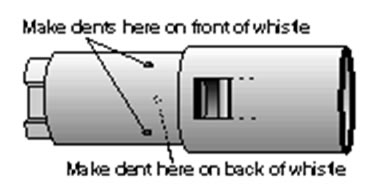 NOTE: This method works much better than glue, which will not stand up to differential expansion and contraction of the wood and copper.
NOTE: This method works much better than glue, which will not stand up to differential expansion and contraction of the wood and copper.
Shaping the Mouthpiece (the part of the fipple that goes in your mouth)
- Place the fipple in a vice and cut the exposed end of the dowel off flush with the end of the copper pipe.
- Clean out the upper end of the channel in the fipple plug so that you can clearly see its lower edge.
- Use a hacksaw to cut off a triangular section of the pipe and dowel. Start the cut at the end of the fipple, with the hacksaw blade parallel to and about 1-2 mm below the lower edge of the wind channel. As soon as you have a cut a small slot that will keep the blade from slipping, tilt the hacksaw blade to cut downward at about 45 degrees (see below).

- Smooth the cut surface (wood and copper) and the outer edge of the pipe using first the large flat file, then the sandpaper.
- Blow off all loose dust and clear out the mouthpiece again.
- Mix a good two-part epoxy and spread it over the exposed wooden end of the fipple (and the copper around the edges). In choosing the epoxy, remember that this stuff, when hardened, will be going into your mouth. The epoxy should be the consistency of honey (and is about as easy to control). You want to apply enough so that it will mound up, creating a nice, smooth surface, but not so much that it will flow off the wood into the mouthpiece or down the sides of the fipple (see below).
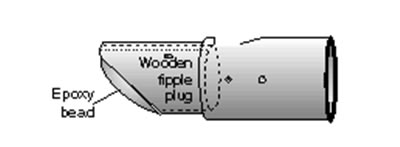
- Set the fipple so that that the wooden surface is level as possible and let the epoxy harden overnight. If a little epoxy flows onto the sides of the fipple you can flake it off with a screwdriver.
- Your fipple is now complete! (except for the polishing).
Making the Body
- Attach your fipple to the end of the 26-cm length of pipe and blow gently and steadily. Once the copper pipe has warmed up to your breath, compare the note with a tuner or electronic keyboard. It should be a D, one octave above middle C.
- If your D is in tune, great! Continue to step 3 below.
- If the whistle is a bit flat, you need to shorten the main tube a little at a time, until it comes into tune.
- If the whistle is just a little bit sharp, try pulling the long tube out from the fipple slightly. If you can bring it into tune without pulling it out too far, make a mark on the main tube showing how far out it should be for correct tuning. Each time you check tuning, make sure the fipple is slid out to this same spot.
NOTE: If the fipple won't stay in one place because the sleeve is loose, cover the sleeve with a cloth and tap on it with a hammer to put it slightly out of round. This should make it hold more tightly onto the main pipe. - If the whistle is way sharp, it probably wants to be an E-flat whistle instead of a D whistle. If you want a D whistle, cut a new (longer!) piece of copper pipe. If you want an E-flat whistle, keep cutting off short pieces until you get a low note of E-flat. Then use the hole ratios below to figure out where the holes should go (the hole sizes may change also... remember to start small).
- Using a pencil and ruler, draw a straight line up the front of the body of the whistle (or use an existing striation in the copper).
- Use the ruler and pencil to make marks along the line at the following distances from the bottom of the whistle:
Note Hole Distance Proportion Diameter E Hole 1 4.4 cm 0.15 3/16" F Hole 2 6.6 cm 0.25 9/32" G Hole 3 8.3 cm 0.31 1/8" A Hole 4 10.7 cm 0.40 7/32" B Hole 5 13.0 cm 0.49 1/4" C Hole 6 14.8 cm 0.56 1/4" NOTES:
1) The ratio labeled "Proportion" in this table is the distance from the bottom of the whistle to the center of the finger hole divided by the total acoustic length of the whistle. (In this case, the acoustic length is the distance from the bottom of the whistle to the lower edge of the fipple hole, or 26.5 cm).
2) This table lists just one possible set of hole positions and sizes. Many different position/size combinations are possible. See the Notes on Tuning for suggestions on how to adjust these factors to create your own hole arrangements.
- Use the punch to make pilot "dents" to guide the drill bit at each of these locations.
- At Hole 1 (the mark closest to the bottom of the whistle), drill a hole slightly (about 1/16") smaller than the size shown in the table above under "Diameter" Use the rattail file to clean up any burrs from inside and outside of the hole.
- Blow into the whistle with the hole covered. This should give you your low D (in tune). Now lift your finger and play the new note (low E). Check it against your tuning standard. It will probably be a bit flat. If so, choose a drill bit 1/32" larger and open up the hole slightly. Check the note again. Remember that there is no easy way to make a hole smaller if you open it up too far (creating a note that is too sharp). See some notes on tuning below for additional details.
- When the note in the low octave is in tune, try playing the same note one octave up, and check the tuning of this note as well.
- Repeat this process for each of the holes, starting at the lower end of the whistle and working your way up to the top.
Some notes on tuning:
- Always warm up the whistle before tuning it by blowing through it for a few minutes.
- Try to use the same breath pressure for all notes, so that a note does not seem sharper or flatter just because you are blowing differently. This is especially tricky for the highest notes (high A and above), which often have to be blown harder to keep them from being flat.
- Try each note in both the low and high octave. In some cases you may have to compromise on hole size and placement.
- For the higher notes (A and B especially), you will have to work out a compromise because they will play rather flat in the high octave unless you open them up a bit wider than would be optimum for the lower octave. This may be something that might be solved by optimizing the hole placement, but I have not yet found any placement/hole size combination that will completely eliminate the problem.
- The tone of any given note is controlled primarily by the size of the uppermost open hole and it's position on the whistle. It is also affected by all the open (or closed) holes below it. This is why you always drill holes and tune the notes starting at the bottom of the whistle.
- Enlarging a hole makes the note sharper. Drilling a smaller hole creates a flatter note.
- Moving a hole up the whistle makes the note sharper. Moving a hole down makes the note flatter.
- Given the above, if you want to make a whistle with larger holes, you will have to move all the holes down a bit. This applies to individual holes as well--if you move a hole down, you have to make it larger to get the correct note.
- Also given the above, if you want to make a whistle with smaller holes, you will have to move all the holes up a bit. This applies to individual holes as well--if you move a hole up, you have to make it smaller to get the correct note.
- Smaller finger holes make for a more quick, responsive whistle, but they also make a quieter whistle. Conversely, larger finger holes make a louder whistle (and perhaps one with a mellower tone), but it won't feel as "quick" or "lively."
- There is no way to use hole size and placement to compensate for a whistle whose body is cut too short or too long--the tonic note will always be off.
- If you want to make a hole slightly larger, but don't have a drill bit of the next size up, you can use your existing bit to widen the hole (sideways or up the whistle). However, the resulting holes won't look as neat, and you need to make sure you can still easily cover them with your fingers.
- When you have all made and tuned all six holes, use the rat-tail file to clean up any remaining burrs from inside and outside the whistle. Then take a small piece of sandpaper and wrap it into the shape of a small cone (about the size of a pencil tip). Work this around in each of the finger holes to smooth them out, until they feel good on your fingers. Start with 80- or 120-grit and move up to 180- or 220-grit.
Finishing the Whistle
After you have finished all tuning and shaping, you are ready to make the whistle shine. I highly recommend using a DUST MASK for this stage of the process, even if you haven't used one for previous steps.
- Start by buffing the entire whistle with a extra-fine-textured green plastic scouring pad. Use this pad to work out any gouges or sandpaper scratches and to do final smoothing around the edge of the finger holes. You can work on the fipple too, but stay away from the epoxy-coated area, which scratches easily.
NOTE: You can buff either parallel to the long-dimension of the whistle or at right angles to it (by twisting the pipe within the pad), but not both. You get a different sheen depending which direction you buff, and you can decide which you like better...) - Now buff the entire whistle again using extra fine (000) steel wool. Buff in the same direction that you used with the plastic pad, and stay away from the epoxy bead on the mouthpiece. When you are done, you should have a really nice shine. While you are doing this final polishing, wear gloves or hold the whistle in a cloth to avoid getting fingerprints on it. When you are done buffing, wipe off the entire whistle with a clean paper towel or cloth.
- To keep the shine for more than a day is really tough! I am currently using four coats of spray lacquer. This stuff is nasty, so make sure you have good ventilation. The air temperature also needs to be warm and not too humid... I also suggest masking off the part of the fipple that goes in your mouth, so that you don't get lacquer on it.
- Another approach is to use several coats of wax, such as Minwax wood finish. I apply at least three coats, letting each coat dry (about 10-15 min) and then buffing it out with a soft cloth before applying the next coat. Do not wax the part of the fipple that goes in your mouth. The wax coating eventually wears through, especially where your fingers contact the whistle. At that point, you can buff it out again (if necessary) and wax it again.
I have tried other coatings, but have found that they are much more of a hassle and take longer to dry. Even the lacquer will wear off with time. With the epoxy I have had adhesion problems. Other waxes, such as car waxes, may also work but I haven't done much long-term testing with these.
Another alternative is to let the copper darken naturally. I rather like the look of copper after it darkens. I've also been experimenting with various compounds to create reddish or greenish patinas.
Congratulations! You have created your own copper pennywhistle. Even if it is not perfect, it has your spirit in it... and you can always try again. Another advantage of making your own whistles is that you can make them in any key, depending on the music you are playing.
